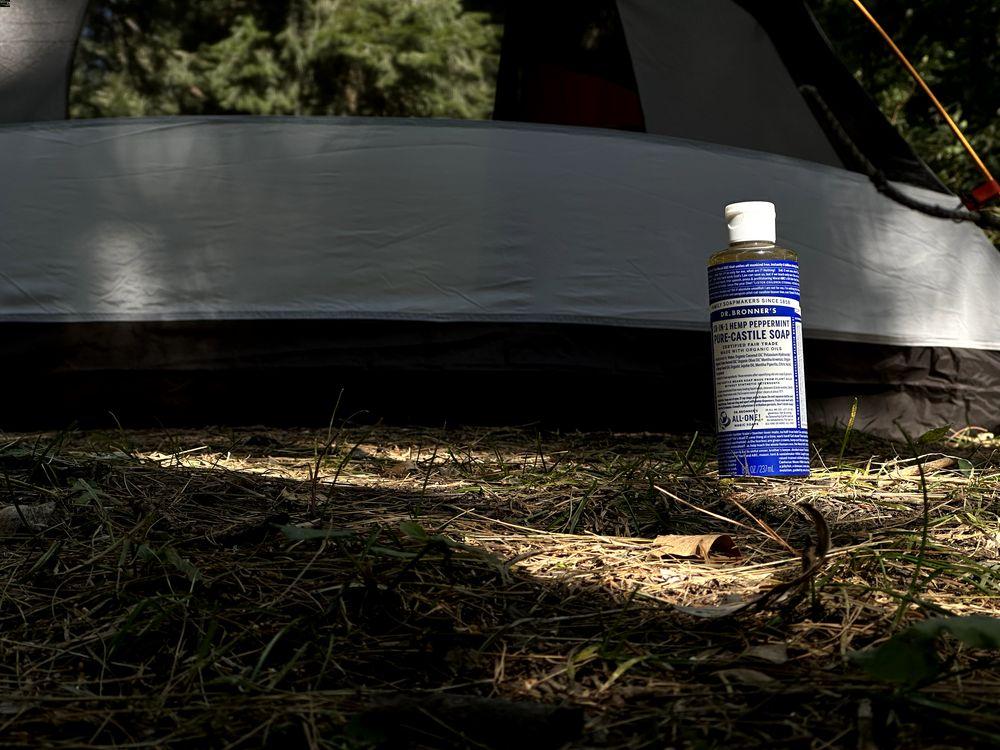We all want a healthy environment and lifestyle, whether at home, outdoors, or anywhere in our outdoor adventure. You know that humans contribute a lot to polluting the environment overall. Research by The National Center for Biotechnology Information shows how soap and its packaging impact Mother Nature, especially during the pandemic when people use soap more frequently.
But how can you contribute to preserving mother nature, not just for yourself but also for the next generations? The answer is by using Biodegradable products. Soap is one of the most commonly used that can be replaced with biodegradable soap. But before going further, what is biodegradable soap?
Biodegradable soap is made from natural ingredients that decompose or break down easily without creating waste to avoid environmental pollution, unlike ordinary soap, which contains some harmful ingredients and doesn’t dissolve and create pollution. Palm oil, coconut oil, and fruit extracts are expected natural ingredients for making biodegradable soaps.
Here are our top picks for the best biodegradable soaps:
Best Overall Biodegradable Soap
1. Dr. Bronner’s Pure Castile Soap
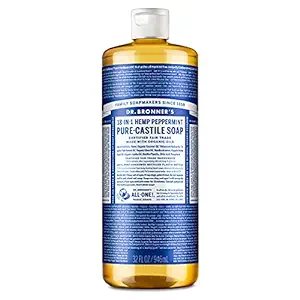
Dr. Bronner’s Castile Soap is the best biodegradable soap made from harmless natural ingredients and is highly popular among backpackers and campers. This is our favorite due to its quality, portability, and packing, which made it easy to carry and use wherever we want on the trail or campsite. In addition to routine cleaning and bathing, you can use this soap as shampoo or toothpaste; there is no need to carry shampoo and toothpaste separately.
During our testing while camping, we found it was efficient to clean our cooking utensils while removing the oil, even if the water was cold. It performed better than other competing soaps which we tested. While using it as shampoo and toothpaste, we did not feel any taste or discomfort as you get it from the regular soap if you have ever tried it as toothpaste.
We also found it friendly and gentle for sensitive skin due to its natural ingredients that don’t cause irritation or skin dryness. In addition, a small bottle of Dr Bronner’s Castile Soap is enough for many outdoor trips as it’s highly concentrated. Put water and a small quantity of Castile soap in a small bowl.
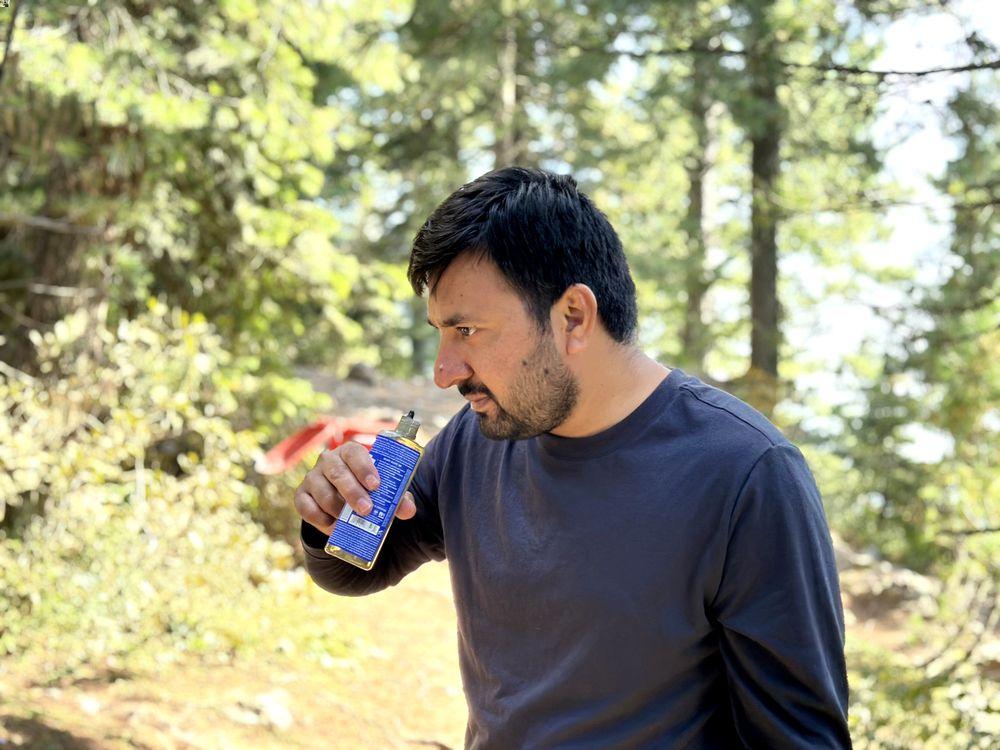
Mix it well; it won’t create much suds like the ordinary soap you use at home, but it does the job well. If you want to take it for backpacking, take a small empty bottle and then fill it with Liquid Soap as it’s too heavy to take a big bottle for backpacking. Try it at home to know how much you use for baths, toothpaste, and other day-to-day activities.
The peppermint scent is pleasant and gives a refreshing feeling after a bath. This multi-use use soap is excellent for hikers, backpackers, and campers alike, with its quality and dense concentration helping serve extended outdoor trips.
Read Full Review Dr. Bronner’s Castile Soap
Best Of The Rest
2. Sea To Summit Wilderness Wash
Sea to Summit Wilderness Wash is a versatile, biodegradable formula used for laundry, hands, baths, dishes, and all-purpose cleaning during camping and backpacking. Like pure castle soap, it’s also a highly concentrated liquid soap, which performs excellently to remove oil and dirt from dishes after pure castle soap.

The bottle is pretty tough with a small nozzle and tight lid, so it does leak even if you put it under heavy items in your backpack. It works well for cleaning dishes, body, and gear; you can even use it for shaving and as shampoo like other degradable soaps. The compact bottle is valuable to pack, thus saving useful space in the backpack.
It’s gentle on fabrics and skin but a bit tough on stains. It’s fragrance-free; if you are looking for some fragrance, it’s not for you. You can even take this bottle on the plane as it’s tiny and allowed to be taken.
However, Sea to Summit Wilderness Wash has a few drawbacks. If you have big hair, you might have trouble cleaning it quickly and thoroughly as it does not perform well like regular shampoos. It won’t be enough for more heavy cleaning, like washing gear, etc., and we suggest taking a bigger bottle.
3. Coleman Camp Soap Sheets
If you are an ultralight backpacker and don’t want to carry liquid or bar soap, Coleman Camp Soap Sheets are an excellent option due to their lightweight and compact design. You can fit this in your pocket or a small space in your backpack as they will only take up a little space. These soap sheets are unscented and biodegradable and won’t impact the environment, and you can freely use them on the trail or while camping.
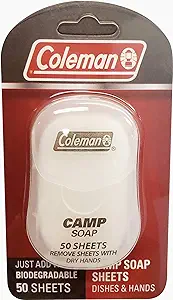
How do I use these sheets? Take some water and dissolve them, and you will get sudsy lather water, unlike Castle soap and See to Summit wilderness wash. Coleman Camp Soap Sheets are a great way to keep your hands clean and refreshed while enjoying the outdoors.
Coleman Camp Soap is perfect if you are on short hikes. However, if you are camping and cooking, we advise you to use Castile Liquid Soap if you need a soap to use more often. Otherwise, you will have to carry a few packets of these sheets, which are less effective than the other two we reviewed. However, these are easy to use; you need water to wet your hands and then rub the soap on your hands. The soap will lather up and clean your hands well. The soap is also very gentle on your skin, so it doesn’t dry out your skin as some other soaps can.
They are very cheap and compact. If you can, we suggest you take them with you even if you carry liquid soap. Another significant benefit of these soap sheets compared to liquid soap is that you can use them much more quickly. With liquid soap, you often dilute it before using it, which can take a significant amount of time.
4. CONCENTRATED CAMPSUDS Soap
AMPSUDS Soap is another solution for campers and travelers due to its lightweight design, environment friendliness, and effectiveness in cleaning yourself and your gear while on the trail.
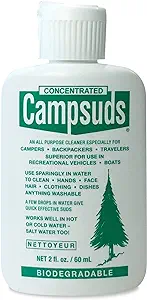
Unlike Sea to Summit Wilderness Wash, this comes with the peppermint oil fragrance, in case you like to use fragrance-based soap. This soap is made with vegetable-derived ingredients to make it gentle for mother nature and your skin and body. This super-concentrated can wash clothes, bath soap, shampoo, and anything washable.
Additionally, this soap works very fast to clean the body or gears without causing any irritation on the skin. We noticed that it cleans the gears efficiently and quickly, even if dirty. Moreover, this soap is safe for skin, hair, and clothes as it does not harm the skin. We have used it at home and during camping to wash our stuff.
Its performance is also reasonable compared to Dr Bronner’s Pure Castile Liquid Soap. It’s good for backpackers due to its compact design and lightweight.
Biodegradable Soap Alternative For Camping: Wipes
Biodegradable Wipes are an alternative option to biodegradable soaps.
Wipes are easy to use, and they don’t require water. In addition, you can find wipes made with ingredients that are safe for the environment. Soaps are also an option but require water and can be harsh on the skin. Wipes are a good choice for people with sensitive skin or who don’t want to use soap.
In addition, wipes are easy to store and transport since they are lightweight and compact.
Here are quick recommendations:
Biodegradable Soap Types
Here are the three main types of biodegradable soap
Liquid
Liquid soaps are the most popular type of biodegradable soaps, which are easy to use and widely available from stores to online markets. However, these are a bit expensive compared to other kinds of soap. But these soaps are highly concentrated and can be used long.
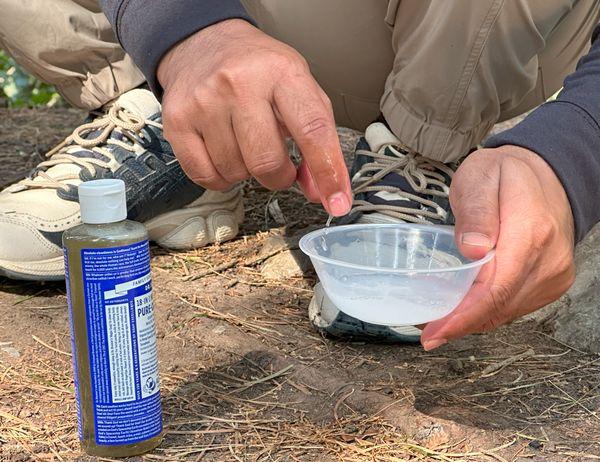
We prefer liquid soaps because they are easier to store after use than soap bars. For example, if bar soap gets wet, it becomes difficult to carry, and you have to be careful as it becomes soft after a few uses.
But liquid, on the other hand, packed in a bottle is a much safer option. They can be used for a variety of purposes during camping. Dr Bronner’s Pure Castile Liquid Soap and CONCENTRATED CAMPSUDS Soap are good options.
Bar Soaps
Bar soap is the second most popular type of biodegradable soap. They are less expensive than liquid soaps; you can easily find them in stores and markets. These are the traditional soap bars that you usually use at home.
Bar soaps are not as easy to use and manage as liquid soaps during hiking or camping. They get wet after use, and you must put them carefully as they become soft. However, bar soap is a more convenient option on the go than liquid soap since it does not require carrying a separate container to dilute it.
Soap wipes/ Power Soap
Powder soap and soap wipes are the least popular type of biodegradable soap. This is because they are more difficult to use than liquid or bar soap. Still, they are the most affordable type of biodegradable soap.
How to Choose Biodegradable Soap. Our Testing Results And Analysis: Buying Guide
Choosing and evaluating if the soap is biodegradable is difficult, as many companies might need more clarification on the ingredients used to make the soap.
How can you know if the soap is biodegradable?
First, you must do proper analyses and research to understand the biodegradables and how they work. Then, take a closer look at the ingredients, including packaging and production methods, to better understand if they’re biodegradable.
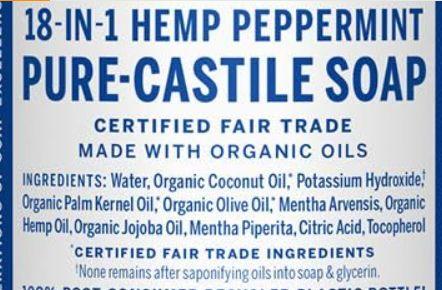
However, based on our comprehensive research, experience, and discussion with industry experts, we shortlisted the best biodegradable soap using different performance parameters, including its ingredients, packaging, and production method.
Furthermore, we looked into other properties of the soap, such as smell, texture, lather, etc., which are mainly personal preferences, but we still consider them. However, the most important thing we believe in when choosing biodegradable soap is how quickly it breaks down in the environment after being disposed of. We also looked for alternatives to traditional soaps that may be more eco-friendly and biodegradable.
Ingredients
It is essential to check the ingredients carefully. Make sure that the soap is certified as being biodegradable, and, if possible, also try to learn a bit about the manufacturers. The soaps reviewed here all have natural ingredients and can be used anywhere outdoors.
The ingredients might vary from company to company based on the formula. Some use coconut oil, vegetable oil, fruit extract, etc., but they should all be natural.
Packaging
Many people don’t realize that biodegradable soap packaging can also harm the environment. Most biodegradable soap packaging is made of plastic, which takes hundreds of years to decompose.
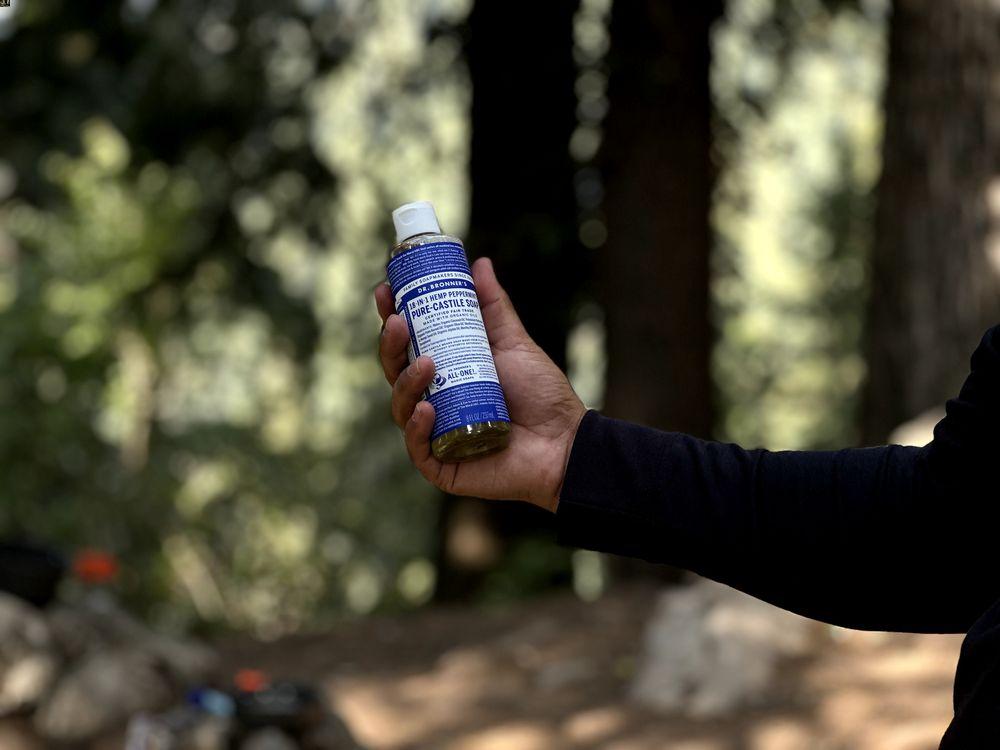
In addition, biodegradable soap packaging contains harmful chemicals that can leach into the soil and contaminate groundwater.
It is important to ensure that your biodegradable soap packaging is environmentally friendly. One way to do this is to choose a brand that uses recycled or recyclable packaging, like Castle liquid soap. Another way to ensure that your biodegradable soap packaging is eco-friendly is to avoid excessive packaging brands.
Ease of Use
You’ll want to ensure the soap is easy to apply and rinse without leaving any residue. In addition, it’s important to find a soap that will work well with your skin type. Liquid soaps such as Castile Liquid Soap and CAMPSUDS are generally easy to use and store during camping.

Wipes are good on the go but can be difficult to keep if wet. The same applies to bar soaps. Liquid soap is concentrated and must be diluted before use, while powder soap also needs water to activate it. As a result, soap bars can become wet and difficult to store after use.
However, liquid and powder soap are generally more versatile and can be used for various purposes, which we mentioned initially. Bar soap is traditionally used for personal hygiene but also cleaning. So, based on our experience and research, we recommend using liquid soap.
Price
Liquid concentrated soap is typically more expensive than bar soap. Still, it can be used for a more extended period. Bar soap is usually cheaper but only lasts for a short time.
Therefore, when deciding which type of soap to buy, it is essential to consider how often it will be used and how long it will need to last. For example, suppose you are only going to use the soap occasionally.
A soap bar may be a better option since it will not need to be replaced often. However, suppose you are going to use the soap daily. In that case, a liquid concentrate may be a better investment since it will last longer.
Scent
Well, if you are an experienced camper, you will know about the scent and bears. Soap scent can attract bears. Make sure you choose soap accordingly, which doesn’t attract the bears. If you are camping where you are certain there won’t be any bears, you can go with your choice of scent.
Peppermint has been shown to repel some bugs, but it is ineffective against all insects. If you are concerned about insect pests, then it is best to use a bug spray in addition to soap. Some scented soaps can be pretty intense, while others are more subtle. There are also unscented options available.
FAQs
What does Biodegradable mean?
“Biodegradable” refers to materials broken down by natural processes such as bacteria, fungi, and other organisms. This process is also known as decomposition. Decomposition is a natural process that recycles nutrients back into the environment.
Biodegradable materials are made from renewable resources such as plants or animals. Once these materials are decomposed, they provide essential nutrients for new plant growth.
In contrast, non-biodegradable materials such as plastic or metal do not break down naturally. They can persist in the environment for centuries. The accumulation of these materials can cause significant environmental damage. Therefore, it is essential to use biodegradable products whenever possible to help protect our planet.
How To Use Biodegradable Soap During Camping?
Most people know soap is biodegradable, which breaks down into smaller pieces over time. However, many must learn that it can still negatively impact the environment, mainly when used near water sources.
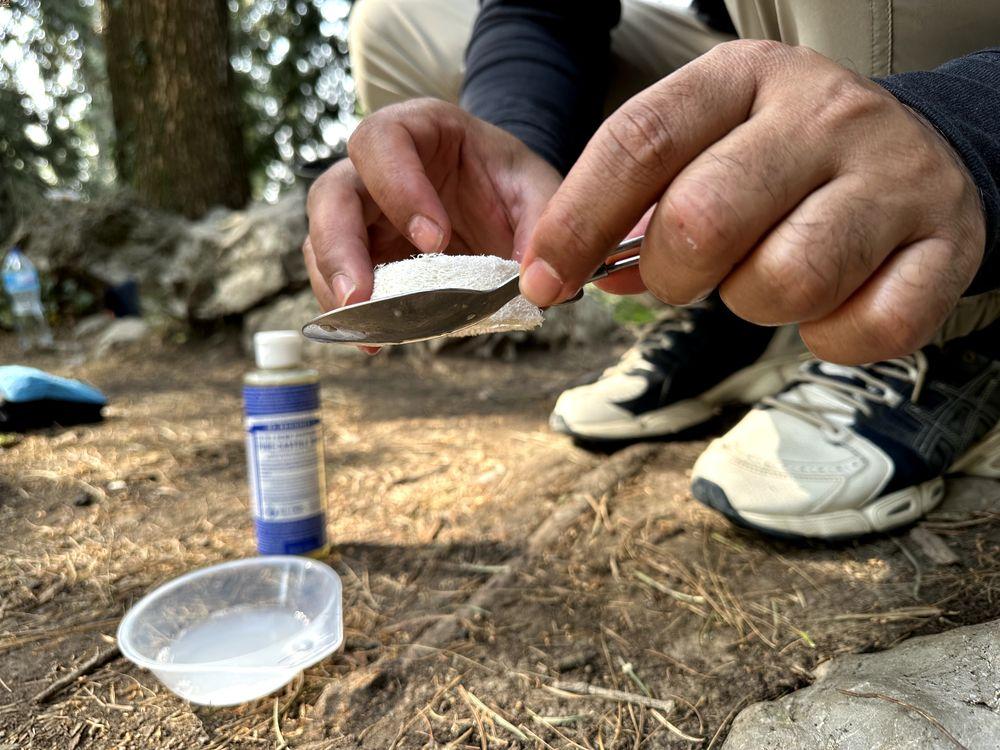
For example, soap in a stream or lake can damage the ecosystem’s delicate balance and harm aquatic life. In addition, soap can pollute waterways, which makes them unsafe for swimming and fishing. Therefore, using soap at least 200 feet away from water sources is best. This will help protect the environment, clean and safe waterways, and Leave No Trace.
How To Make Biodegradable Soap
Making biodegradable soap is easy to make at home for camping. It requires a few simple natural ingredients that you can find easily in kitchens or stores. In addition to the below-mentioned ingredients, you can also use the combination with different natural oils. You need to
ensure all are natural, like coconut oil, palm oil, etc.
To make biodegradable soap, you will need:
- 1 cup of vegetable oil
- 1 cup of lye
- 1 cup of water
- essential oils (optional)
Instructions:
- Mix the vegetable oil and lye in a glass container. Aluminum can react with the lye, so try to avoid it.
- Stir until the lye is fully dissolved.
- Add some water and keep stirring until the mixture thickens and becomes cloudy.
- Add essential oils, if preferred.
- Pour the soap into a container and let it cool for 24 hours.
- Cut into bars and store in a cool, dry place.
Summary
We reviewed the best biodegradable soaps for camping and outdoors that are safe to use and won’t harm nature. It’s also our responsibility to protect our environment while hiking and backpacking using biodegradable products and educate fellow campers and backpackers. Take any of these soaps on the trail, and you will be happy that you are keeping yourself clean and protecting our planet for the coming generations.
Let us know in the comments if you have ever used biodegradable soap and what your experience was on the trail.
Related:
